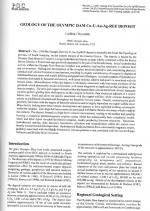Добрый день, Коллеги. Важное сообщение, просьба принять участие. Музей Ферсмана ищет помощь для реставрационных работ в помещении. Подробности по ссылке
Geology of the Olympic Dam Cu-U-Au-Ag-REE deposit
The -1590 Ma Olympic Dam Cu-U-Au-Ag-REE deposit is located in the Stuart Shelf geological province of South Australia, on the eastern margin of the Gawler Craton. The deposit is hosted by the Olympic Dam Breccia Complex, a large hydrothermal breccia system wholly contained within the Roxby Downs Granite, a Proterozoic age granitoid inteipreted to be part of the Hiltaba Suite. Initial hydrothermal activity within the Olympic Dam Breccia Complex was probably localised by structures in a dextral fault jog environment. Subsequent development of the complex involved repetitive and overprinting physical, chemical and volcanic brecciation mechanisms, resulting in a highly variable array of irregularly shaped and distributed breccia zones with widely differing and gradational lithologies. A complex pattern of hydrothermal alteration dominated by hematite and sericite, with lesser chlorite, siderite and quartz is associated with the breccia zones. Mineralisation within the deposit is intimately associated with iron-oxide alteration of the granitoid, which dominantly occurs as hematite, with lesser magnetite at depth and on the periphery of the breccia complex. The principal copper minerals within the deposit show a broad lateral and vertical, hypogene zonation pattern grading from chalcopyrite on the margins to bornite, then chalcocite adjacent to a central barren core. Gold and silver are mainly associated with the copper sulfides, while uranium dominantly occurs in pitchblende disseminated throughout the hematitic breccia zones. Overall, mineralisation grade generally correlates with the degree of hematite alteration and is largely dependent on copper sulfide tenor. Minor brittle faulting post-dates breccia development and appears to have exploited existing anisotropies within the complex. Late-stage fault movements are associated with barite-fluorite vein arrays which overprint the orebody. The deposit formed in a high level volcanic environment, venting to the surface and possibly forming a composite phreatomagmatic eruption crater, which has subsequently been completely eroded. Mafic and felsic dykes intruded the breccia complex, locally producing diatreme structures. Tectonism, hydrothermal activity, dyke intrusion, brecciation, alteration and mineralisation within the system were broadly concurrent and interdependent. Hydrothermal fluids and metals have a dominantly magmatic source, probably associated with the Middle Proterozoic volcano-plutonic event correlated with the Gawler Range Volcanics and Hiltaba Suite intrusives.




